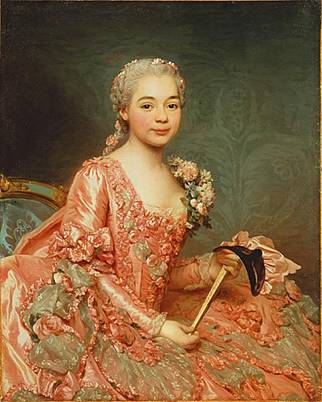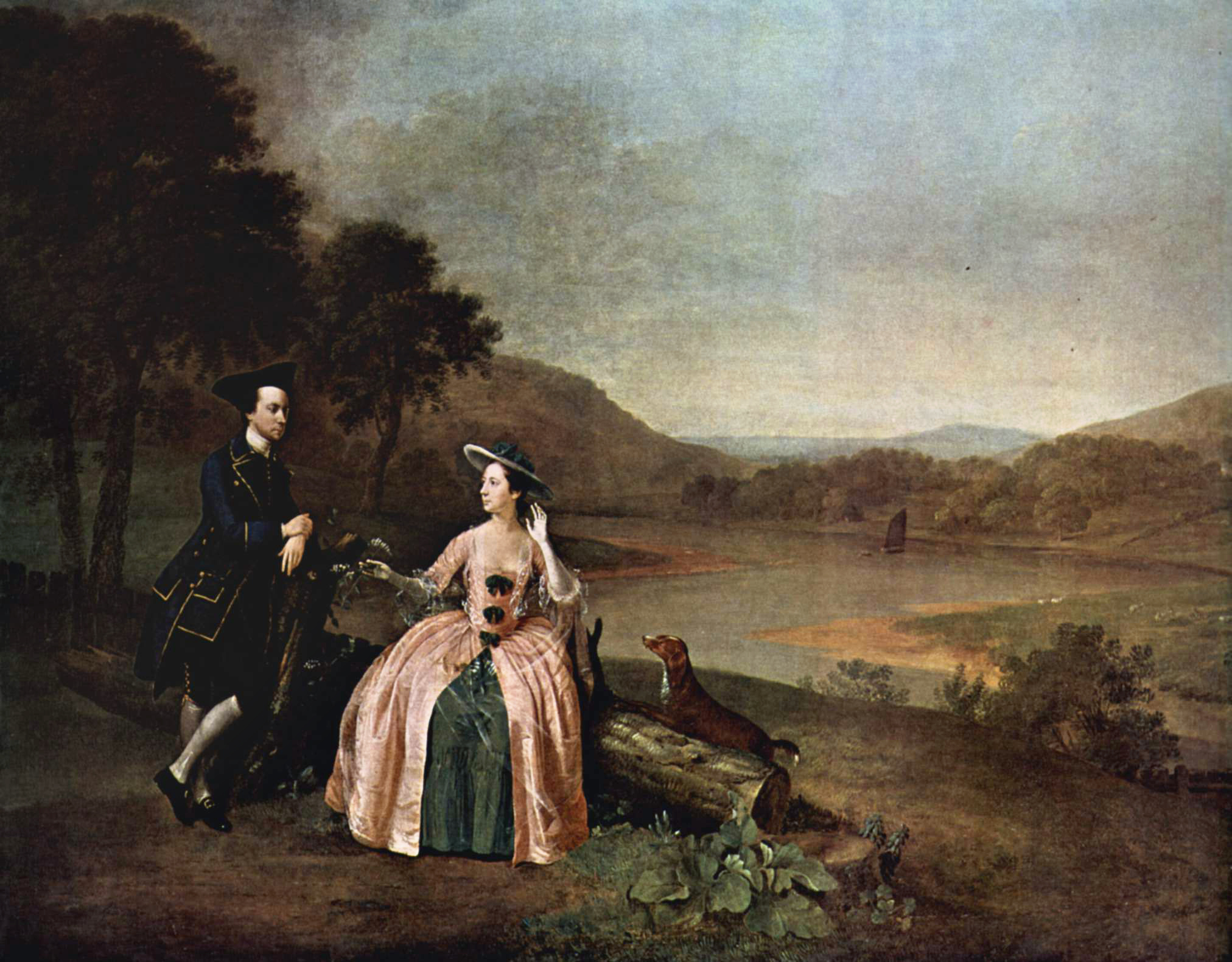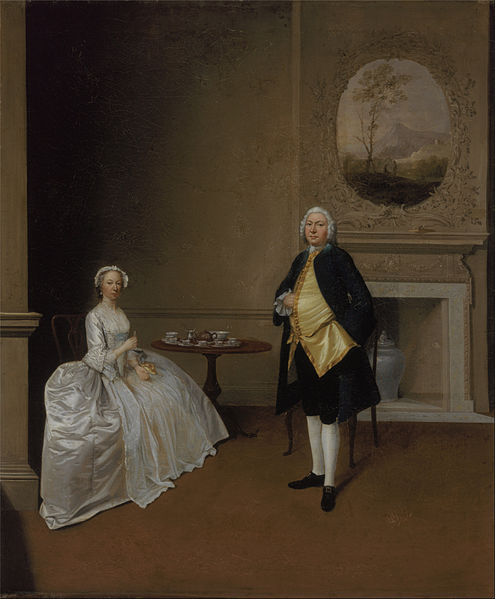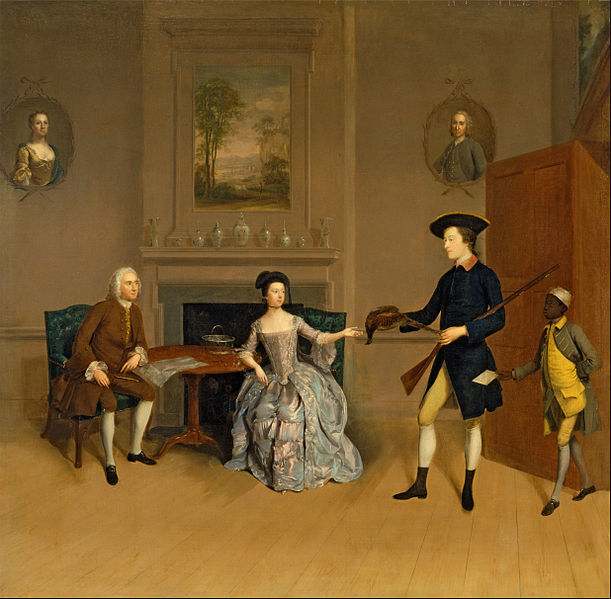1750’s Images and Costumes:
Here is a collection – well, as much as this page can handle! – but it’s a collection of paintings, engravings and clothing dated to the 1750’s. We’ve tried to add our notes and details of description. Hope you find them informative and useful.
The Fanshaw Mantua – 1752-53:
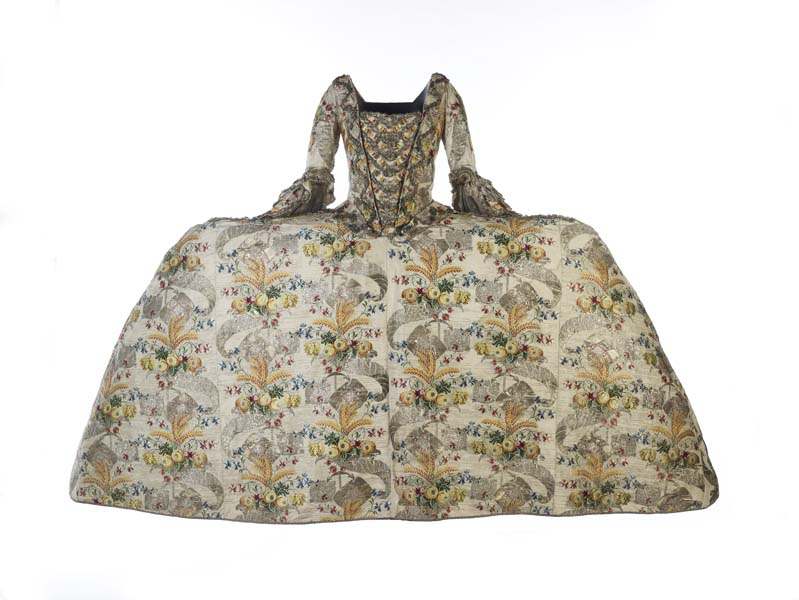
Front View
Details:
– We have a more detailed page dedicated for this dress on our page ‘Ann Fanshaw’s Mantua‘ if you’d like to have a look.
– Mantua with fitted petticoat and stomacher
– 3 x lace-edged ruffles to the sleeves.
– Fairly deep robings.
Baroness Crumiere – 1756:
Details:
– This painting is from France so it may not match British Fashions.
– The image is also small, so we’re unable to zoom in but the furbelow trim seems either puffed in places, gathered and drawn into a rose shape or shaped by stab stitching. The trim that comes diagonally down her bodice looks like it could possibly be tightly gathered strips in an entwining weave and sewn down the centre (which is a basic standard type of furbelow trim).
– The Front edges of the skirt has a lace mixed with furbelow. (We are assuming it is a skirt and petticoat as there does seem to be a conjunction in the bottom left corner). It is either a complete trim, mounted on ruched and gathered furbelow with the lace placed on top and partly gathered up with it and then the roses/puffs sewn on top of the lace to create a weave effect OR the lace has been edged with the narrower trim (same as on the side of the bodice) and the puff/rose again placed on top of the lace. We favour the latter as the lace on the petticoat has also been edged with this narrow furbelow trim.
– The stomacher appears to be the same fabric but ruched up and with a centre line of what definitely look like self-fabric roses. She then wears a sash-style decoration of a slimmer lace puffed in the same way as the skirt trim but without the thinner furbelow, and the rose/puff placed on top.
– Petticoat is heavily decorated, it’s unclear as to how low it goes but the top certainly has swathes of lace with trim and either puffed trim lining the top of the lace or it’s a row of roses.
– The dress is a sack with standard robings over a stomacher. Classic to the Sack was ruffles at the cuff but it is unclear if this dress has these. There certainly seems to be a lot of fabric round the elbow area and she wears a bow/sleeve knot in amongst everything else. This dress could also possibly be a Brunswick. The reason for this possibility is the long sleeves extending from under the standard shorter sleeve. It’s a bit over decorated for a travelling dress which is what the Brunswick mostly was. It could be that France had a fashion for long, tighter sleeves at this time, perhaps it was winter…who knows these things!?. These tighter sleeves also have a run of roses/trim going down to the wrist.
– Also, what’s predominant and could totally change all the logic behind the dress, is that it is for a masquerade (see the mask in her hand). Masquerade dresses could have a theme, be an imitation from a portrait, be just simply over-dressy. Whatever the reason behind it, it is a massively beautiful and heavily decorated dress.
– Other details: She possibly wears her own hear but powdered and with the same self-fabric roses in it.A very fine shift, with light gathering is visible along the neckline of her dress and a small, short frill at the cuffs. She wears no visible jewelry.
The Stricklands – Arthur Devis – 1751
Details:
– We like it when an image tramps all over our understanding! The lady is painted wearing what looks like a very 1770’s style dress – petticoat with gathered bottom-hemmed frill and Bodice CF closing gown without apparant ruffles at the sleeves. We know that throughout the eighteenth century there is a trend of Undress (or ‘day wear’ or ‘negligee’s’ or ‘night gowns’ – depending on what term you like to use!) becoming fashionable dress. Sacks, for example, started off as a form of Undress and the Anglais was the basic stock of Undress until the 80’s when it blended into the Polonaise. So it could be that this style of Anlgais (or just plain ‘gown’ as it was often referred to during this period – in many letters sacks were sacks (Robe a la Francais) and gowns were what we now call Robe a l’Anglais’) developed into the fashions of the 70’s. As she is in a park it’s not unnatural that she would be in Undress.
– She has 3 ribbons at the CF join – more commonly known as ‘Echelles’ but not sure this can really be used for only 3 knots! Anyway, they are in a green that matches the petticoat.
– Her ruffles at the cuff pretend to come from the shift (meaning: not from the dress) but really are probably ‘sew on’ as a) it’d be ridiculous to have a shift that fine and b) they match the Apron and Handkerchief about her neck.
– She wears her own hair and unpowdered, a Bergere Hat or ‘Straw Hat’ with a dark green ribbon, also matching bows and petticoat. The colour of the dress is this beautiful peachy/salmony colour, quite similar infact to the ‘Baroness Crumiere’ image above. Perhaps it was a fashionably colour in the early 50’s.
– He wears a matching 3 piece suit with gold braid around the pkt and front egdes of both the jkt and the w/c, and gold buttons and a tie on the breeches. His pkt flaps are broad and square with no shaping.
– He wears white stockings under his breeches, a white high stock, a tricorne hat and black shoes with buckles.
Mr and Mrs Hill – Devis – 1750-51:
Details:
– She wears a white satin/taffeta silk Robe – probably an Anglais as no fabric at the back for the sack is visible. The skirts are wide and possibly worn with a hoop which would account for the box-ish shape of the skirts side nearest us.
– Her cuffs are a wide and deep ‘Seperate Cuff’ (modern day term) and possibly ruched = there seems to be a slight texture visible in this image. she seems to be wearing lace ruffles that come quite long and not too full. Her sleeve shape seems to be fairly broad and not cut to the slimness that these dresses develop in a few years time. Her dress features the classic Robings with stomacher underneath and she has a blue bow or something lacing at the top which her handkerchief is tucked through. She wears this handkerchief full. Her apron is long and fine, though not as fine as the impossible one above. the end of her stomacher seems to sit clearly over her apron. It’s nice to see they’ve struggled getting the satin or taffeta seam to sit cleanly and has that ‘Sleeping bag’ appearance to it.
– She is also wearing a necklace style choker – it’s very vague but there is a definite line there. And also a cap or a pinner perched on the back of her probably powdered hair.
– He wears a dark coloured jkt with deep cuffs – wide rather than deep as they don’t go upto his elbow and seem to have some detail of trim or embroidery along the top of them. He has ruffles from his shift and an old fashioned (by now anyway) loose tie at his neck – as far as we’re aware these were mainly fashionable in the early 1700’s but may well have had a comeback. The ladies deep cuff seems slightly of an older fashion aswell so it may well be that in their age they are keeping to the fashions they wore when they were slightly younger. Jacket is collarless.
– His w/c is yellow and vastly buttoned with a similar coloured satin ribbon (?) along the edge. It does have pockets but his ahnd it shoved into what appears to be his breeches pocket.
– Breeches are black with his white stockings tucked in under.
– He also wears his w/c like many other gentlemen in their portraits; buttoned at the top and lower waist with the mid section left undone. You can see his hand here, tucked in to this mid section.
John Orde and His Wife Anne and Eldest Son – Devis – 1754-56:
This is an amazing painting. The detail on the ladies dress is incredible.
Details:
– John Orde wears a goldeny-brown 2 piece suit. Jkt has either a Wing cuff or a shortened Boot Cuff/Deep Cuff which has covered buttons along the top of the cuff. He has pleats at the side of atleast 3 folds. It’s collarless and with a slightly curved CF edge with covered buttons.
– His waistcoat is a golden yellow and fairly long as you can it’s front edge slither over his thigh.
– She wears a stunning probably two-tone dress or what is commonly called ‘shot’ satin or taffeta. But what is uite exciting here is the angle of her stays – you can just see the CF ridge – busks could be quite big and also angled to give a defining look to the outer shape of the dress – here hers creates this angled look. It’s so exciting spotting this in paintings!
– The necline of her dress doens’t come that low but she wears it fairly high – this is also nice to see – it’s so easy to assume that all aldies went round with their incredibly low necklines and bosoms near on the point of bursting out. In this image she wears it nice and comfortable looking but that doesn’t take away from the stunning look of the dress.
– She has a wide gathered trim on her petticoat with another line of shorter gathered trim above it. Her robings look to be trimmed with a furbelow which then could go on into the skirt – it certainly appears that way. Her Stomacher also looks mildly decorated with furbelow trim – sometimes these furbelows could be sewn down quite flatly which could be whats happening here. The bottom of her stomacher comes down quite far also and you can see that if the Stay point is beneath that (under the petticoat is one possibility or under the stomacher itself -debatable) it would certainly change the way she’d sit. The skirts of her robe also come at an odd place on her stomacher – kind of breaking into the stomacher but we’ve noticed this in dresses that we’ve studied in the museums – the stomachers could sometimes be quite long.
–

